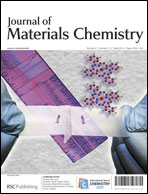The control of molecular architectures has been a key factor for the use of Langmuir–Blodgett (LB) films in biosensors, especially because biomolecules can be immobilized with preserved activity. In this paper we investigated the incorporation of tyrosinase (Tyr) in mixed Langmuir films of arachidic acid (AA) and a lutetium bisphthalocyanine (LuPc2), which is confirmed by a large expansion in the surface pressure isotherm. These mixed films of AA–LuPc2 + Tyr could be transferred onto ITO and Pt electrodes as indicated by FTIR and electrochemical measurements, and there was no need for crosslinking of the enzyme molecules to preserve their activity. Significantly, the activity of the immobilised Tyr was considerably higher than in previous work in the literature, which allowed Tyr-containing LB films to be used as highly sensitive voltammetric sensors to detect pyrogallol. Linear responses have been found up to 400 μM, with a detection limit of 4.87 × 10−2 μM (n = 4) and a sensitivity of 1.54 μA μM−1 cm−2. In addition, the Hill coefficient (h = 1.27) indicates cooperation with LuPc2 that also acts as a catalyst. The enhanced performance of the LB-based biosensor resulted therefore from a preserved activity of Tyr combined with the catalytic activity of LuPc2, in a strategy that can be extended to other enzymes and analytes upon varying the LB film architecture.

You have access to this article
 Please wait while we load your content...
Something went wrong. Try again?
Please wait while we load your content...
Something went wrong. Try again?


 Please wait while we load your content...
Please wait while we load your content...